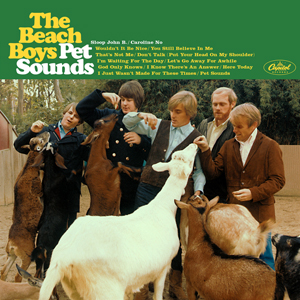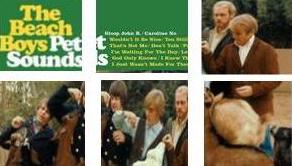Giles Martin "ZOOMs" In" to Introduce His Atmos "Pet Sounds" Mix at New York's Dolby Screening Room
the mix master intended to attend but a family emergency prevented it
"Pet Sounds" didn't have a stereo mix for Giles Martin to fix. The album was meant for mono and mixed to mono because that's how Brian Wilson hears. Wilson produced the original mono mix and all acknowledge its brilliance. The same is true of George Martin's mono Beatles mixes, produced not because Martin heard in mono, but because that's how most kids back then consumed music. The pre-production strategies targeted the mono releases and with limited available tracks the stereo mixes were often compromised. Neither The Beatles nor the producer cared as much about the stereo mixes, especially on the earlier albums, though many Beatles fans still prefer them, flaws and all.
Giles Martin was tasked with fixing his father's stereo mixes, taking advantage of modern technology and the results are commendable even to "original pressing" purists. For instance does anyone really prefer hearing George Harrison singing "Here Comes the Sun" isolated on the right channel instead of centered?
The Pet Sounds task was different. The mono original issued in 1966 was the only available legitimate version. The "Duophonic" release was Capitol's grotesque 'fake stereo' process best ignored. Using the original multitrack tapes Mark Linett created a new stereo mix for 1997's The Pet Sound Sessions 4 CD box set release that provided a kind of techno-guide for Giles Martin's later Beatles re-mixes. Fortunately, wise people on both sides of the EMI/Capitol enterprise understood the value of the multitrack work parts of The Beatles recordings and Pet Sounds and the tapes were not erased and re-used. Linett's stereo mix was later issued by Analogue Productions and is an excellent vinyl stereo issue version of the album.
In the ZOOM call Martin discussed the Linett stereo mix and the original mono mix. As I recall his comments he said while he listened to the stereo mix and consulted with Linett, ultimately he found the reverb too "wet" for his tastes and chose to model his Atmos "spread" after the original mono mix's drier reverb profile. At the same time he rightly said that mono was an "immersive" format and that a wide spread does not necessarily produce "immersion". He also made clear that he understood that pulling elements too far apart could destroy musical cohesion. So, with the mono mix as a guide and the later stereo mix as a reference, he set about producing his Atmos mix. Of course, he also talked about the music on Pet Sounds—how Brian brought in jingle-writer Tony Asher to write lyrics and how it influenced The Beatles (and everyone else at the time making pop music)—how it prodded The Beatles to make Sgt. Pepper's.... But surely you already know that.
The lights went down in the Dolby Screening room and the Pet Sounds Atmos mix began. Let's start with this: a movie theater is not an appropriate venue for album music playback, whether monophonic, two channel, four channel or multi-channel. The enormity of the sonic images produced by the Dolby screening room's system, never mind the inappropriately excessive SPLs, turned many of the music's percussive elements into sound effects and Brian Wilson and the other Beach Boy vocalists into menacing giants. The opening drum slam on "Wouldn't It Be Nice" was isolated and so far removed from the rest of the music it sounded like a dynamite explosion in another room.
The Atmos mix in the theater threw familiar musical elements, once comfortably tucked within the tidy mono mix, into vast stretches of isolated space where they appeared almost detached from the main event. The wood block on "Let's Go Away For Awhile" became an enormous event instead of an accent. The overall theater sound was bright, hard, "cardboardy" and off-putting—the opposite of "immersive". Familiar string elements that should sound "springy" and "plucky" sounded hard and edgy. I was expecting that because before the Pet Sounds playback there was a Dolby video advert played stupidly loud that sounded awful and "cardboardy". A lightning sizzle had no textural or transient sizzle. It sounded like undifferentiated white noise. So I was prepared.
What I was hearing was everything Martin said he'd hoped his mix would avoid. The album is heavily percussive and rhythmically complex, but the theater's spatial and "sound effects ready" presentation, combined with the excessive SPLs (admittedly I was sitting in the front 1/3 of the room) produced relentless pounding and a diminution of the mono mix's generous textures and along with it the dense mysteries buried within that make the mono version so immersive. With everything isolated in space—unraveled— yes, you could hear more of the individual elements in the mix, but the mix itself and the art behind it went missing.
As the album played the analogies flowed in my head: "He's turned Pet Sounds into an Enoch Light album (of course the title track sounds like an Enoch Light production combined with an "I Love Lucy" Wilbur Hatch orchestrated ending). "This is like filming porno under fluorescent lights". "Dolby should open at Atmos restaurant and serve the world's most famous dishes in Atmos where instead of tasting the dish, each spice and ingredient sits isolated in your mouth. You can taste every element as never before but the goddamned dish is missing!"
When it was over and the lights came up, there was at first silence followed by the most tepid applause that sounded more obligatory to avoid embarrassment than an enthusiastic reaction to what the audience had just heard. When the floor opened for questions the obsequious ass-kissing began. "Oh, Giles, you've done it again!" followed by meaningless questions required to cover the opening ass kiss.
On the way out a video cameraman asked attendees about the experience. I looked into the camera and said "A movie theater is not an appropriate place to present a record album". I might have said "a stupid place".
Happy Ending

Can we all agree that the Pet Sounds album cover is among the worst and ugliest ever created for one of the greatest albums in recorded popular musical history? When it was first released I mistook it for something Capitol's budget Pickwick label would produce and I fully expected to see a collection of older Beach Boys tunes haphazardly chosen. Tacky, generic type face, ugly composition, 1/3 of the cover a green band on top, a terribly stilted picture of "the boys" uncomfortably feeding farm animals. Awful! It looked nothing like the album sounded!
On Friday June 2nd the album "dropped" in Atmos on TIDAL. It was supposed to also be on Amazon but i couldn't find it and I don't subscribe to Apple Music. I couldn't find it on TIDAL either until I learned it was only on TIDAL's phone app, where I found it and was able to use Airplay to get it into my dCS Vivaldi One streaming DAC.
Played back in stereo on a good two channel system had me rescinding everything I thought of the mix when I walked out of the screening room other than that yes, a screening room is the STUPIDEST place on earth to present a music album, I don't care if it's multi-channel Atmos or not, especially since 100% of the young people this is aimed at are never going to hear Pet Sounds in the full Atmos spread version. They'll hear it on headphones or as I did at home in stereo.
Played back in stereo on big speakers, produced a masterfully mixed two channel spread, with textures intact and an overall warm, not icy cardboardy, timbral balance, similar to what I've been hearing in the mono mix (best vinyl version IMO is either the DCC Compact Classics edition or the Carl and the Passions "two-fer" or the single LP Reprise edition released at the same time). The mix is firmly "in the pocket" and cohesive, leaving no elements "out to dry". Perhaps the vocals on the first few tracks are too "out front" for me, but that's about the only criticism i had. The bottom end is deep and firm, transients are clean and the midrange warm and inviting. You want the record to sound and feel like 1966 and it does.
Martin's remix is preferable to Linett's overly "wet", somewhat glassy one IMO (A/D converters have improved since 1997 for sure) and it's got a more intimate feel overall that's similar to the original mono mix. Do we really need at Atmos mix? Your call. But I think Giles Martin has produced an excellent Atmos mix that sounds better in stereo at home than it did spread across the universe in a movie theater. If you have TIDAL or Apple Music and can Airplay it to your streaming DAC I think you'll enjoy the listen.
The original mono tape has gone missing. How about a new AAA mono mix that duplicates the original?










































.png)








